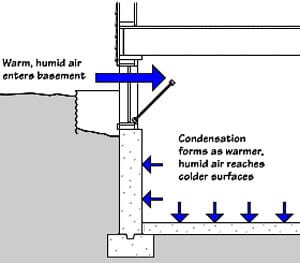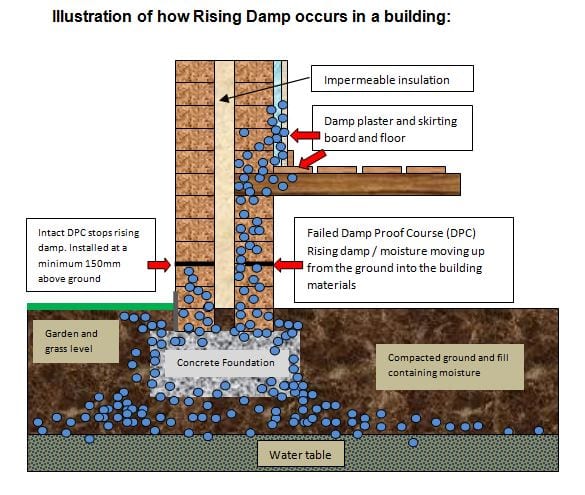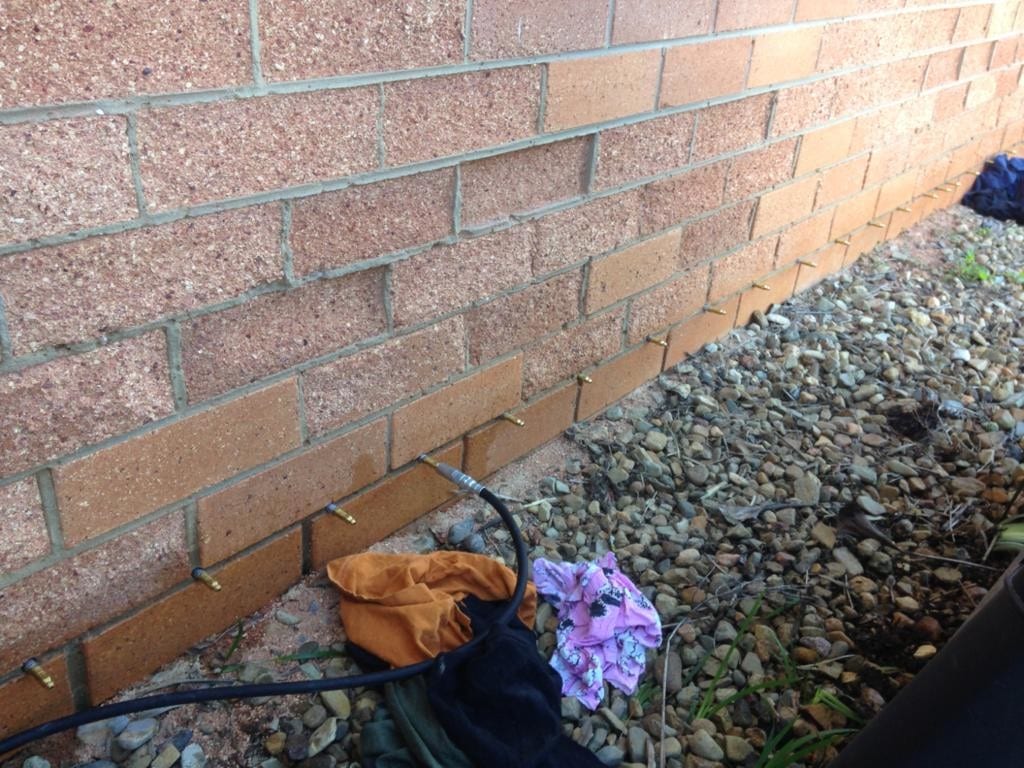
09 Jan Damp patches on walls after rain – What could it be?
DAMP PATCHES ON WALLS AFTER RAIN – WHAT COULD IT BE?
What causes damp in internal walls and what are the signs of penetrating damp, condensation and rising damp to look out for?
After a day or more of heavy rain, we hear from a great number of homeowners and facility & asset managers that they have noticed damp patches on the walls.
There are many causes of excess moisture in the structure of a building, such as leaking pipes and damage to gutters and roofs. However, a high proportion of damp problems in buildings are caused by rain penetration, condensation or rising damp. In this blog article, you will find what signs to look for, what type of damp problem they may represent and how they can be treated and repaired.
Diagnosing the cause of dampness in a building is vital so that correct treatment and repair can be carried out to address the source of the problem. When the diagnosis is wrong, the treatment fails and the damp issue remains.
Many of the visual signs of the three main categories of dampness in buildings may look quite similar to the untrained eye. This is why penetrating damp and condensation can be mistaken for rising damp or vice versa.
Damp walls also encourage mould growth, which can lead to health problems for occupants. The key component for mould growth is excess moisture. Moisture can come from outside (i.e. penetrating or rising) or be generated indoors (i.e. condensation).
It is worth noting that damp patches and/or mould are not always visible and you may have hidden mould and/or damp:
- There is a mouldy/earthy odour
- There is regular condensation indoors
- The home feels regularly humid.
Common sources of moisture include:
- Surface water leaking into the building
- Wet building foundations (eg. rising damp)
- Rain leaking in through the roof or walls
- Poor ventilation
- Showering, cooking and boiling without adequate ventilation (exhaust fans/open windows)
- Use of clothes drying racks and heaters without adequate ventilation
- Indoor plumbing leaks
- Indoor liquid spills
- Storing large amounts of water-absorbent materials, such as books or cardboard boxes, in a damp space.
There are 3 main categories of dampness:
-
-
-
Penetrating Damp
-
Condensation
-
Rising Damp
-
-

1. Penetrating Damp
Summertime brings us heavy rainfalls, sometimes combined with driving winds that push rain and moisture through the brickwork or masonry. Penetrating damp (or lateral damp) is usually caused by water entering the exterior envelope of the building.
The dampness form isolated patches on walls that typically increase in size after a storm. Penetrative damp can affect at any level of a building, predominately areas that are exposed to severe weather conditions.
In lack of impermeable insulation in the wall cavity, the moisture held in the cavity wall insulation will gradually travel to the inside wall pushing dampness through the plaster coat, paint or wallpaper.
Penetrating damp may take place where there is a defect in the roof, render, brickwork, clogged or damaged gutters or downpipes and window frames that allow for water to enter the building materials.
Commonly, penetrating damp occurs on external walls where the external ground levels are higher than the internal floors or there is an incorrect fall away from the building. The consequence is that the rainwater cannot efficiently run away from the walls, causing dampness to seep through.
These damp patches may appear as shadows on the wall or cause the paint to bubble up and crack.
Common signs of Penetrating Damp are
- Discolouration of the interior decoration with the presence of tide marks
- Damp patches that grow if the water continues to enter, especially during heavy rain
- Depending on severity: Wet surface or droplets trickling on the surface
- Salt deposits
- Blistered (hollow sounding) plaster
- Wet and/or rotting skirting boards are quite often exhibiting corroding nails.
- Random damp patches to any elevation on the walls and ceilings.
- Damp skirting board
- Dark mould on inside walls, near skirting board or near window frames.
Treating Penetrating Damp
If the cause of the penetrating damp has been identified as failing guttering, window/door frames or roofing, these need to be repaired as well as replacing damaged plaster and timber work.
If the water is entering through the wall to floor joint, an effective and lasting remediation is to inject the joint with flexible hydrophilic polyurethane along the length of the wall to floor joint.
The hydrophilic polyurethane grouts seek out water in a crack, they absorb into tight cracks and pores bonding to the wet concrete – creating a very effective and long-term solution in stopping leaks via a concrete crack or construction joints.
2. Condensation
Often, condensation occurs at low levels where the surface of the wall is coolest, starting in a corner and then spreading along the length of the wall. This may appear to be rising damp and can easily be confused.
Condensation problems within a building are usually indicative of humidity and ventilation problems within a property. It is often believed to be caused by building defect, but that is usually not the case. Buildings with inadequate ventilation leave the moisture trapped inside the building, which leads to condensation problems to grow quickly.
Condensation is caused when warm air with vapour comes into contact with cold surfaces and is possibly the most common form of dampness in buildings as a result of inadequate ventilation.

Condensation forming on internal walls
Warm air carries water vapour with it – the warmer the air, the higher the moisture load it is able to support – on contact with cooler surfaces, the moisture in the air condenses to form dampness or water droplets. This can sometimes be mistaken for wall leakage, when in fact the accumulated moisture is from condensation.
Condensation is most likely to occur on the glass in windows, colder parts of walls, around external door and window openings, or where floors or ceilings join with outer walls.
Condensation can also be present in areas where the natural air circulation is reduced or restricted, this is often at the side of or behind furniture that is stood against an outside wall – or inside cupboards. Damp will begin to damage the area affected and patches of black mould growth can appear.
Most buildings will suffer from some condensation especially if you dry clothes inside or use humidifiers. Cooking, showering and bathing produce a higher level of moisture in the air because the warmer the air, the more moisture it will contain. When this warm and moisture loaded air come in touch with surfaces that are cooler, such as windows, cool walls or metal, the air temperature drops and the water vapour condenses into water droplets.
Common signs of condensation are
- Damp walls with blistering paint
- Damaged and peeling wallpaper
- Musty smell
- Black mould growth along the edges of windows, skirting boards and wall to floor and wall to ceiling joints.
- If the dampness has a tide mark on the wall, the dampness may be caused by rising damp or penetrating damp, leaking pipes or faulty roof.
Treating condensation
If the cause of the damp has been identified as condensation, the cure may be as simple as installing a good quality ventilation system that encourages the movement of the air from inside the building to the outside. Damaged plaster and timberwork need to be repaired or replaced.
3. Rising Damp
Sometimes the slow destruction of rising damp can go on undetected for a long time before signs become evident by the deterioration of stumps, footings and building bricks. It may often go on unnoticed for years because of constant, but low levels of moisture absorbed from the moisture in the soil and the surrounding ground by capillary action. A visually detectable bigger leak is usually detected early and repaired within a shorter time frame.
Capillarity is the force that causes moisture to rise upwards through porous material such as concrete. When the concrete footings sit in a pool of water, the concrete will work like a sponge through capillary action, resulting in rising damp travelling up through the concrete foundation and into the building materials of the walls.
The rising damp carries naturally occurring minerals and salts up from the ground through the wetness in building materials such as the concrete footings and masonry walls.
The presence of mould detected by a musty smell may also be one of the first sign of rising damp that you notice. The wet areas affected by rising damp, typically behind skirting boards. Detection often happens when someone opens the wall and finds that the structure behind it is rotten.
Rising damp can be identified by a characteristic whitish powdery tide mark (Efflorescence) on the lower section of affected walls. The water is transporting minerals including salts up through the concrete and other building materials and deposited in the wall and on the wall’s surface. This tide mark is caused by salt being brought through to the surface by the effects of evaporation. These salts accumulate at the “peak” of the rising damp. The areas where the moisture can evaporate is where the damage is the most visible with the salts damaging the plaster and masonry.
10 Common Signs of Rising Damp to look out for
-
- Damp, musty smell
- Damp patches on walls – stains that may be brownish to light yellowish in colour. – Determine that the brickwork/masonry is actually wet and not just the plaster or wallpaper.
- Bubbling, blistered, flaky paintwork around the floor level
- Peeling wallpaper – you may hear a crunching sound (from salts) when you run you hand over the wallpaper
- Tidemark on the wall/raised white deposits (inside and/or outside) up to a metre above the skirting board
- Salts forming on exposed bricks or masonry
- Efflorescence, demineralisation in form of salt deposits in the plaster that may look like blistering patches on the walls.
- Discolouration and black spots if mould above the skirting boards.
- Decaying/rotting timber such as skirting boards, floorboards, floor joists.
- Deterioration of mortar joints

Can rising damp cause salt attack to concrete, brick and mortar?
Salt attack may be in some cases interrelated to rising damp. The term salt damp combines the two concepts of salt attack and rising damp.
While the term rising damp has been commonly used to cover both aspects, it tends to overlook the role of salt, an issue that will become increasingly important as our buildings get older in geographical areas of higher salt, such as near the sea.
In extreme cases, if left untreated over a long period of time, it may cause damage to the joint work resulting in compromised structural stability of the building.
Often the slow destruction of rising damp can go on undetected for a long time before signs become evident by deterioration of stumps, footings and building bricks.
In extreme cases, if left untreated over a long period of time, it may cause damage to the joint work resulting in compromised structural stability of the building.
Rising damp problems often occur because of not having a Damp Proof Course (DPC) installed or having a Damp Proof Course (DPC) that is faulty due to age or incorrect installation.
The function of the DPC is to work as a barrier to prevent moisture rising from the ground into the building structure by capillary action. The Damp Proof Course (DPC) runs horizontally along the bed joint at a minimum height of 150mm above the finished ground level.
Rising damp is seen as moisture moving upwards from the ground by capillary action through the building materials, like masonry and other wall materials. Rising damp occurs on the bases of walls and floors.
A faulty DPC may cause moisture to rise by capillary action through the building materials like a sponge absorbs water. House bricks placed onto damp ground behave in the same way as this sponge, sucking up the water from the wet ground around them, in an upwards motion, hence the name “rising damp”. Bricks and masonry keep on sucking up water as much as gravity allows until it can’t carry itself up the masonry any more, which is usually at around 1 metre, and the damp levels just build up in the affected area.
How to Stop Rising Damp with DPC injections
A Client Case Story:
The Saviour of a Crumbling Cookie – The Waterstop Solutions team to the rescue
Often the slow destruction of rising damp can go on undetected for a long time before signs become evident by the deterioration of stumps, footings and building bricks.
Rising Damp is one of the many types of water ingress issues our clients are faced with. The issue with rising damp is that it often goes on inside the walls undetected for a long time and slowly damages the structure of the building. The signs may be subtle enough not to raise the alarm of the property owner.
Our client had noticed that the brickwork of their home had started to eat away. The bits of cement in the mortar joints were protruding and crumbling into pieces around the perimeter of the house.
The Waterstop Solutions team were called into the rescue to inspect and identify the root of the problem. Our inspector, who has more than 30 years of remedial waterproofing experience from major civil works, diagnosed the deterioration as being caused by rising damp.
Fortunately, the structural integrity of the house is still sound, but if left untreated, it could lead to devastating deterioration.
What we do to provide a Remedial Solution to Rising Damp:
In this case, we injected our own PWR chemical into the mortar joints in the wall creating a Damp Proof Course (DPC). This barrier prevents moisture seeping up through capillary action, and thereby protects the brickworks from further damage caused by rising damp.

In this case, we injected our own PWR (Penetrating Waterproofing Repellent) into the mortar joints in the wall creating a Damp Proof Course (DPC). This barrier prevents moisture from seeping up through capillary action, and thereby protects the brickworks from further damage caused by rising damp.
Have you noticed any damp patches on the walls in your property?
If you have any issues with water ingress, cracking concrete slabs, structural cracks, concrete deterioration, deteriorated joints, moisture, seepage, efflorescence, rising damp and/or high-flow active leaks in concrete structures, we would be happy to assist you. You are welcome to contact us with any questions that you may have.
Brisbane office: (07) 3205 1899
Email: [email protected]
Sydney office: (02) 9346 8308
Email: [email protected]
Click here to view our Capability Statement to find out what other services we can provide you with.
At Waterstop Solutions our goal is to provide innovative, flexible and practical solutions to ensure the best possible outcomes for our clients. We aim to deliver exceptional service to build and maintain long-term relationships with our customers. With more than 60 years of combined industry experience in our management team, we at Waterstop Solutions lead a workforce that is committed to providing a high standard of service. The best measure of our success is the “follow on” works from our existing clients. Our commitment to safety and our impact on the environment always takes first priority. Our approach to quality is to plan; control; monitor and grow from the outcomes. Quality assurance is a tool for us; the client and the supplier to micromanage critical elements of their project that ultimately produces an optimal result. With limited training opportunities for our field of expertise in Australia, we have invested in sending our project manager to Singapore, USA and Germany (recognized leaders in this field) to undergo extensive training. This provides us with the foundation for further development and up-skilling of our Australian workers.

